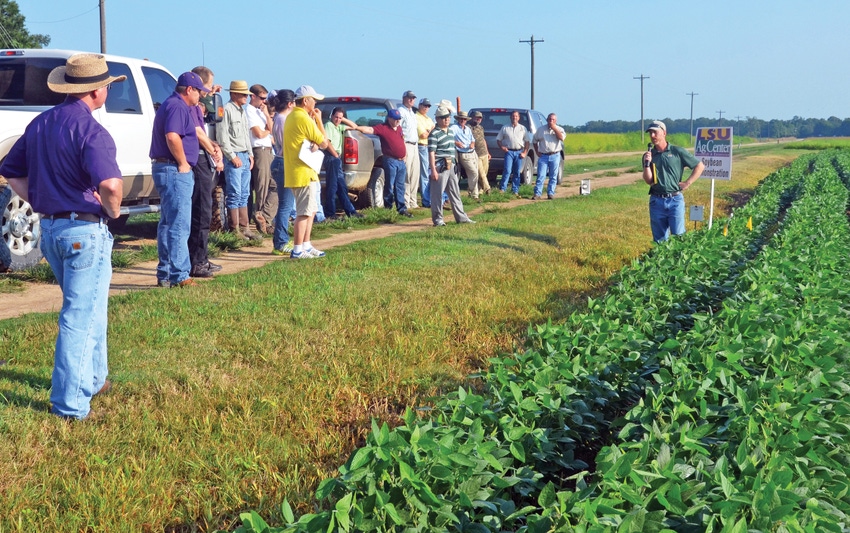July 24, 2014

As the Louisiana rice crop nears maturity and soybeans enter the homestretch, farmers in the southwest area of the state gathered for a field tour at the farm of Charlie Fontenot near Palmetto, La.
Fontenot’s soybeans are between knee- and waist-high, and his rice will soon be ready for harvest. He also has grain sorghum and corn almost ready to cut.
On the field tour, farmers and crop consultants heard from a wide variety of LSU AgCenter experts.
Steve Linscombe, LSU AgCenter rice breeder, told the gathering that several promising lines of hybrid rice being developed at the Rice Research Station in Crowley will be used in off-station testing next year.
Linscombe also said he is testing 250 experimental lines for the Provisia rice system announced earlier this year by BASF. The rice, being developed with conventional plant breeding methods, will be resistant to a grass herbicide that will also control red rice.

Jim Lingo – improving rice production
For Jim Lingo, rice production is about finding ways to do it better, whether it’s on-farm trials or learning from others.
He said most of his work at the Puerto Rico nursery last winter focused on the Provisia rice lines. Provisia will complement the Clearfield system and provide a solution to red rice and volunteer plants that have become resistant to the Newpath herbicide.
Linscombe said the Louisiana rice crop this year has roughly 60,000 acres in medium-grain because of higher prices resulting from an acreage cutback in California where water is in short supply.
But, he said, little Jazzman rice is being grown in Louisiana to compete with foreign aromatic rice. Most of the Jazzman rice grown last year went overseas to countries that are now buying Vietnamese aromatic rice.
“The Vietnamese came in and severely undercut us,” Linscombe said.
Kurt Guidry, LSU AgCenter economist, told farmers not to expect much improvement in soybean prices. He said an 8-million-acre increase across the nation this year with expectations of a good crop have lowered prices. But demand remains strong, he said, and any weather problems could affect prices.
Also, activity from speculators could result in a price bump.
“I don’t think we’re going to get back to $12 soybeans,” he said, adding that prices are likely to run $11 to $11.50 a bushel for soybeans.
Long-grain rice prices are lower because of the 500,000-acre increase in Arkansas, Guidry said, although this year’s rice crop overall is not as good as last year’s crop.
Check Rough Rice Futures Prices
Ron Levy, LSU AgCenter soybean specialist, said the state is poised to set another average record yield, the third in a row. This year’s acreage is 1.46 million, an increase of more than 300,000 acres, he said.
Levy said a 65-acre variety trial at Fontenot’s farm is one of many conducted across the state by the LSU AgCenter.
Trey Price, LSU AgCenter plant pathologist, said he’s getting calls from farmers whose soybeans are affected by root rot disease. He said the condition results in yellowing leaves and occurs at the R-5 to R-6 growth stages. He said no-till farming results in dead plant material that harbors disease during the winter.
Dustin Harrell, LSU AgCenter agronomist, said rice fertilizer recommendations are being reevaluated because of higher yields that remove more nutrients from the soil. Harrell emphasized that the maximum yields are realized when fertilizer is applied at planting.
Eric Webster, LSU AgCenter weed scientist, said he is studying several new herbicides, including two new Gowan products that offer different modes of action.
Don Groth, LSU AgCenter plant pathologist, said rice disease has been light this year. Some blast is being found on CL261 and Jupiter varieties, he said.
Groth said a fungicide-resistant sheath blight that started in Acadia Parish continues to spread, so farmers should use different fungicides to treat the disease. “A resistance management program has to start before you have resistance,” he said.
Johnny Saichuk, LSU AgCenter rice specialist, said more fungicide-resistant sheath blight is being found this year. He said cutting rates for fungicides will lead to resistance.
Jeff Davis, LSU AgCenter entomologist, said the redbanded stink bug population is increasing, and more resistance to acephate herbicide is being found. He recommended using at least 12 ounces of acephate per acre instead of a half-pound application.
Stay current on what’s happening in Mid-South agriculture:
Subscribe to Delta Farm Press Daily.
Davis said farmers should be aware that as fields are treated with a harvest aid, stink bugs will move into later-maturing soybeans.
Julien Beuzelin, LSU AgCenter entomologist, said the Mexican rice borer continues to move east, and it was found in Evangeline Parish this year. He said no threshold has been established for the pest in Texas, but some farmers there spray fields when rice panicles grow to 1-2 inches.
Daniel Stephenson, LSU AgCenter weed specialist, said glyphosate-resistant Palmer amaranth and Italian ryegrass have been found in St. Landry Parish. He urged farmers to clean combines between fields to prevent spreading weed seeds. A pre-emerge herbicide applied in late October will help control herbicide-resistant weeds, he said.
Randy Price, LSU AgCenter engineer, said an air induction nozzle is best for reducing chemical drift. Proper boom height also reduces drift, he said.
You May Also Like




